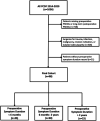The Impact of Preoperative Symptom Duration on Patient Outcomes After Posterior Cervical Decompression and Fusion
- PMID: 35324359
- PMCID: PMC10538330
- DOI: 10.1177/21925682221087735
The Impact of Preoperative Symptom Duration on Patient Outcomes After Posterior Cervical Decompression and Fusion
Abstract
Study design: Retrospective Cohort Study.
Objectives: To determine if decreased preoperative symptom duration is associated with greater clinical improvement in function and myelopathic symptoms after posterior cervical decompression and fusion (PCDF).
Methods: All patients over age 18 who underwent primary PCDF for cervical myelopathy or myeloradiculopathy at a single institution between 2014 and 2020 were retrospectively identified. Patient demographics, surgical characteristics, duration of symptoms, and preoperative and postoperative patient reported outcomes measures (PROMs) including modified Japanese Orthopaedic Association (mJOA), Neck Disability Index (NDI), Visual Analogue Scale (VAS) Neck, VAS Arm, and SF-12 were collected. Univariate and multivariate analyses were performed to compare change in PROMs and minimum clinically important difference achievement (%MCID) between symptom duration groups (< 6 months, 6 months-2 years, > 2 years).
Results: Preoperative symptom duration groups differed significantly by sex and smoking status. Patients with < 6 months of preoperative symptoms improved significantly in all PROMs. Patients with 6 months-2 years of preoperative symptoms did not improve significantly in mJOA, Physical Component Scores (PCS), or NDI. Patients with > 2 years of symptoms failed to demonstrate significant improvement in mJOA, NDI, or Mental Component Scores (MCS). Univariate analysis demonstrated significantly decreased improvement in mJOA with longer symptom durations. Increased preoperative symptom duration trended toward decreased %MCID for mJOA and MCS. Regression analysis demonstrated that preoperative symptom duration of > 2 years relative to < 6 months predicted decreased improvement in mJOA and NDI and decreased MCID achievement for mJOA and MCS.
Conclusion: Increased duration of preoperative symptoms (> 2 years) before undergoing PCDF was associated with decreased postoperative improvement in myelopathic symptoms.
Keywords: myelopathy; patient outcomes; posterior cervical fusion; symptom duration.
Conflict of interest statement
The author(s) declared no potential conflicts of interest with respect to the research, authorship, and/or publication of this article.
Figures
Similar articles
-
Does the Presence of Preoperative Myelomalacia Impact Outcomes Following ACDF?Spine (Phila Pa 1976). 2025 Jul 17. doi: 10.1097/BRS.0000000000005454. Online ahead of print. Spine (Phila Pa 1976). 2025. PMID: 40674109
-
Patients with radiculopathy have worse baseline disability and greater improvements following anterior cervical discectomy and fusion compared to patients with myelopathy.Spine J. 2023 Feb;23(2):238-246. doi: 10.1016/j.spinee.2022.10.005. Epub 2022 Oct 17. Spine J. 2023. PMID: 36257530
-
Determining the time frame of maximum clinical improvement in surgical decompression for cervical spondylotic myelopathy when stratified by preoperative myelopathy severity: a cervical Quality Outcomes Database study.J Neurosurg Spine. 2022 Jun 17;37(5):758-766. doi: 10.3171/2022.5.SPINE211425. Print 2022 Nov 1. J Neurosurg Spine. 2022. PMID: 35901760
-
Influence of Preoperative Severity on Postoperative Improvement Among Patients With Myeloradiculopathy Following Anterior Cervical Discectomy and Fusion.Clin Spine Surg. 2022 Aug 1;35(7):E576-E583. doi: 10.1097/BSD.0000000000001328. Epub 2022 Mar 29. Clin Spine Surg. 2022. PMID: 35344523
-
Preoperative mental health status may not be predictive of improvements in patient-reported outcomes following an anterior cervical discectomy and fusion.J Neurosurg Spine. 2017 Feb;26(2):177-182. doi: 10.3171/2016.7.SPINE16472. Epub 2016 Sep 30. J Neurosurg Spine. 2017. PMID: 27689424
Cited by
-
Duration of symptoms before diagnosis in degenerative cervical myelopathy: A systematic review and meta-analysis.Brain Spine. 2025 Apr 16;5:104252. doi: 10.1016/j.bas.2025.104252. eCollection 2025. Brain Spine. 2025. PMID: 40343073 Free PMC article. Review.
-
Assessment of Clinical Outcomes and Quality of Life Following Laminectomy and Lateral Mass Screw Fixation in Patients With Cervical Myelopathy.Cureus. 2025 Jul 19;17(7):e88311. doi: 10.7759/cureus.88311. eCollection 2025 Jul. Cureus. 2025. PMID: 40831861 Free PMC article.
-
Flipping the mJOA: Clinical utility of the modified Japanese Orthopaedic Association score as a tool for detecting degenerative cervical myelopathy.Brain Spine. 2024 Jun 26;4:102853. doi: 10.1016/j.bas.2024.102853. eCollection 2024. Brain Spine. 2024. PMID: 39040488 Free PMC article.
-
Racial/Ethnic Disparities in Perception of Health Literacy and Barriers to Care Among Cervical Stenosis Patients.Global Spine J. 2025 Jan 30:21925682251318262. doi: 10.1177/21925682251318262. Online ahead of print. Global Spine J. 2025. PMID: 39883593 Free PMC article.
-
[Influence of preoperative symptom duration on effectiveness of cervical disc arthroplasty in cervical spondylotic radiculopathy patients].Zhongguo Xiu Fu Chong Jian Wai Ke Za Zhi. 2024 Feb 15;38(2):176-182. doi: 10.7507/1002-1892.202310071. Zhongguo Xiu Fu Chong Jian Wai Ke Za Zhi. 2024. PMID: 38385230 Free PMC article. Chinese.
References
-
- Nouri A, Tetreault L, Singh A, Karadimas SK, Fehlings MG. Degenerative cervical myelopathy. Spine. 2015;40:E675-E693. - PubMed
-
- Tracy JA, Bartleson JD. Cervical spondylotic myelopathy. Neurologist. 2010;16:176-187. - PubMed
-
- Baptiste DC, Fehlings MG. Pathophysiology of cervical myelopathy. Spine J. 2006;6:S190-S197. - PubMed
-
- Tetreault LA, Kopjar B, Vaccaro A, et al. A clinical prediction model to determine outcomes in patients with cervical spondylotic myelopathy undergoing surgical treatment. J Bone Jt Surg. 2013;95:1659-1666. - PubMed
-
- Fehlings MG, Tetreault LA, Wilson JR, Skelly AC. Cervical spondylotic myelopathy. Spine. 2013;38:S1-S8. - PubMed
LinkOut - more resources
Full Text Sources



